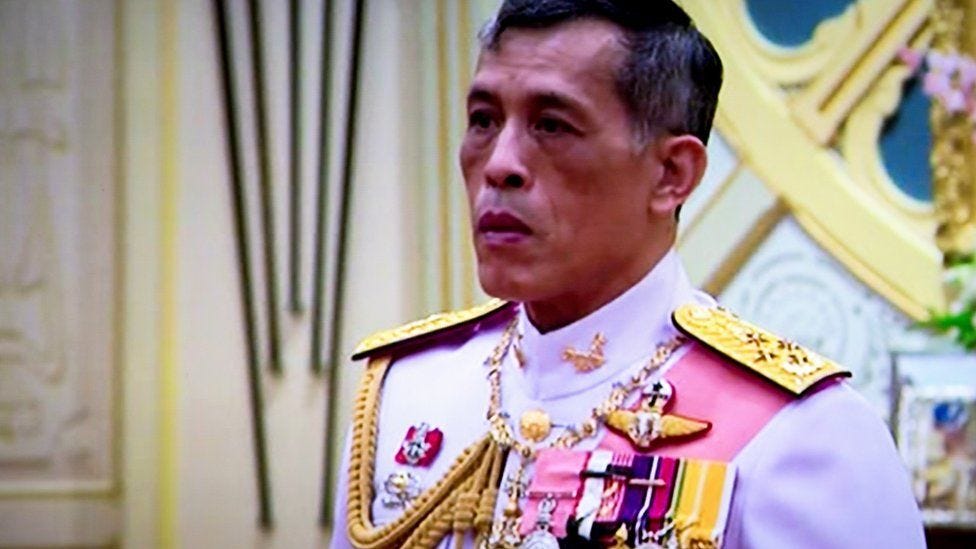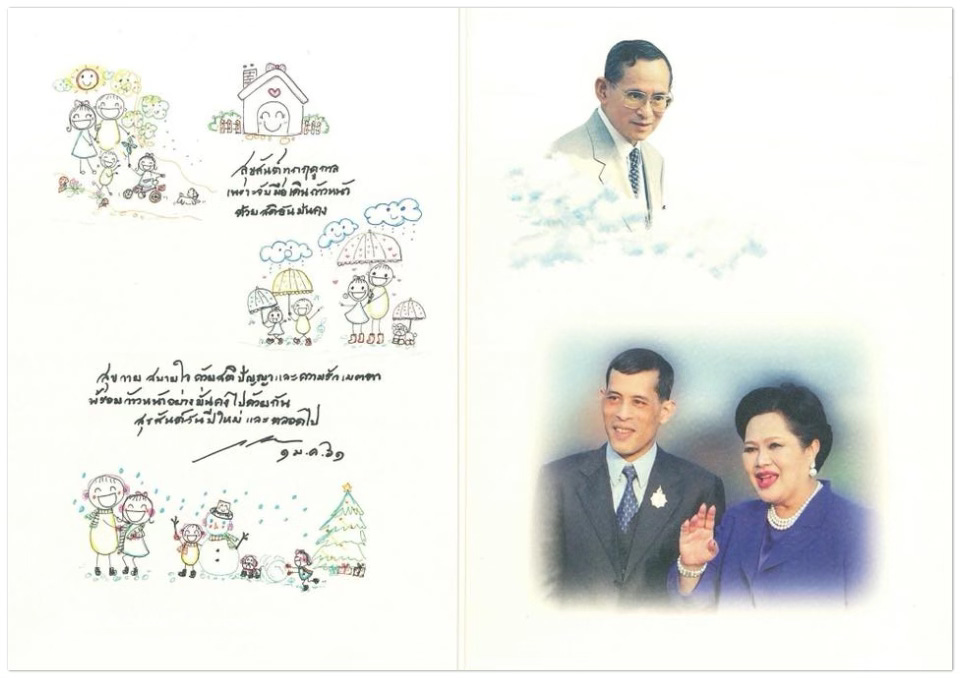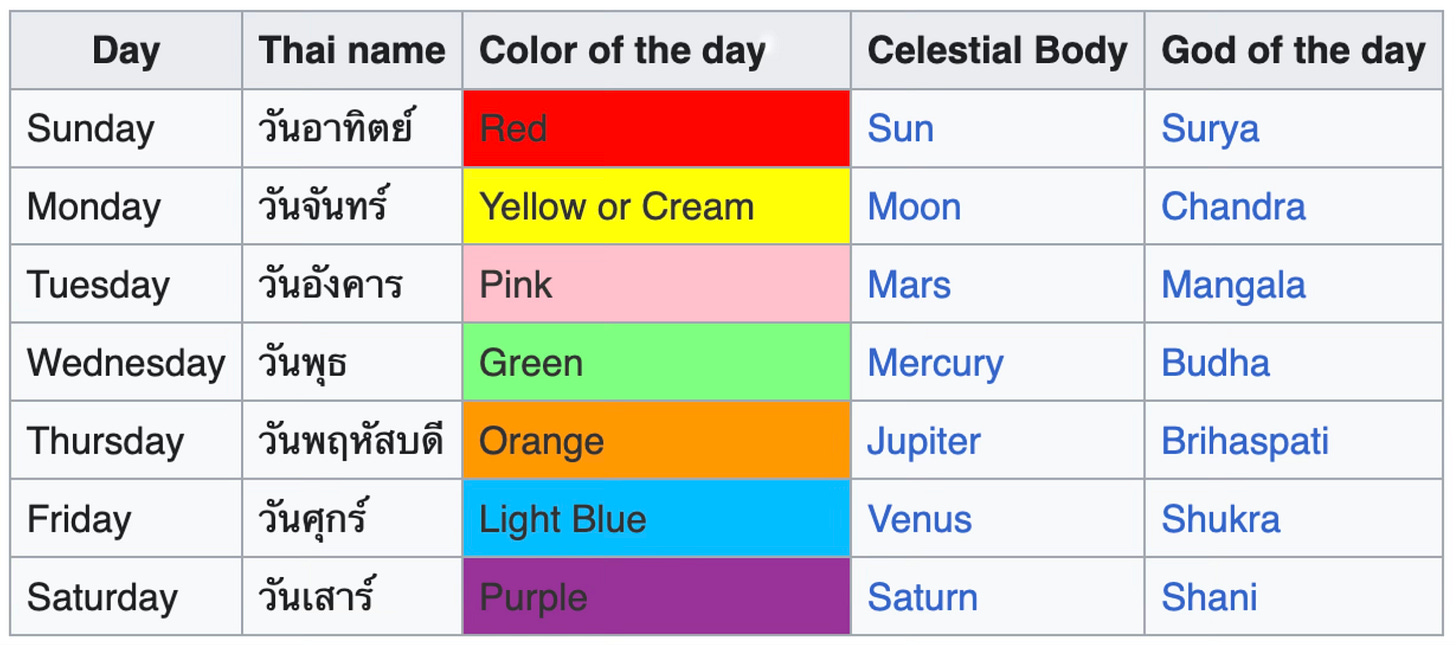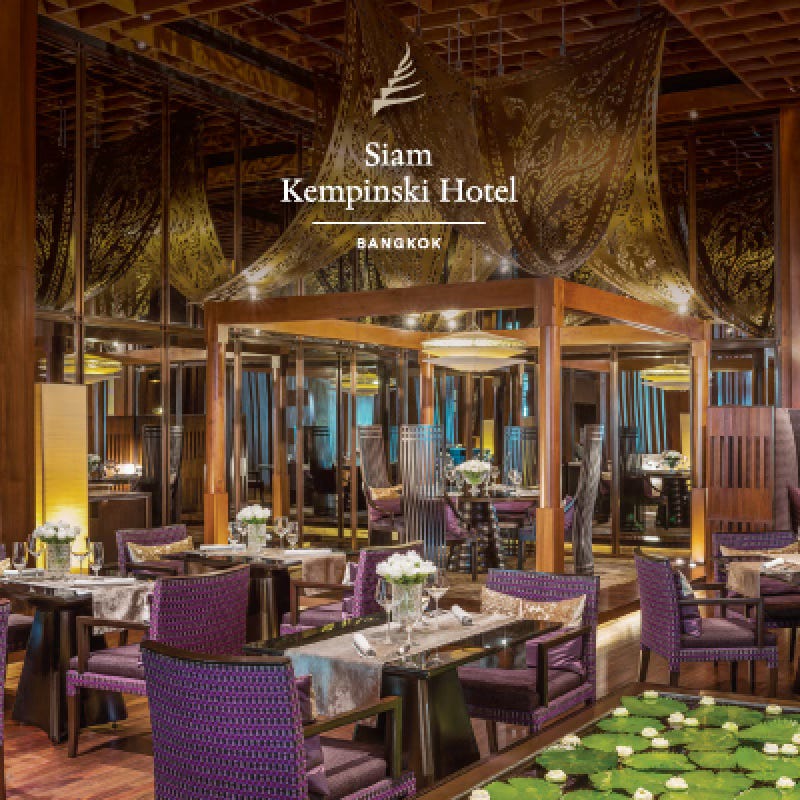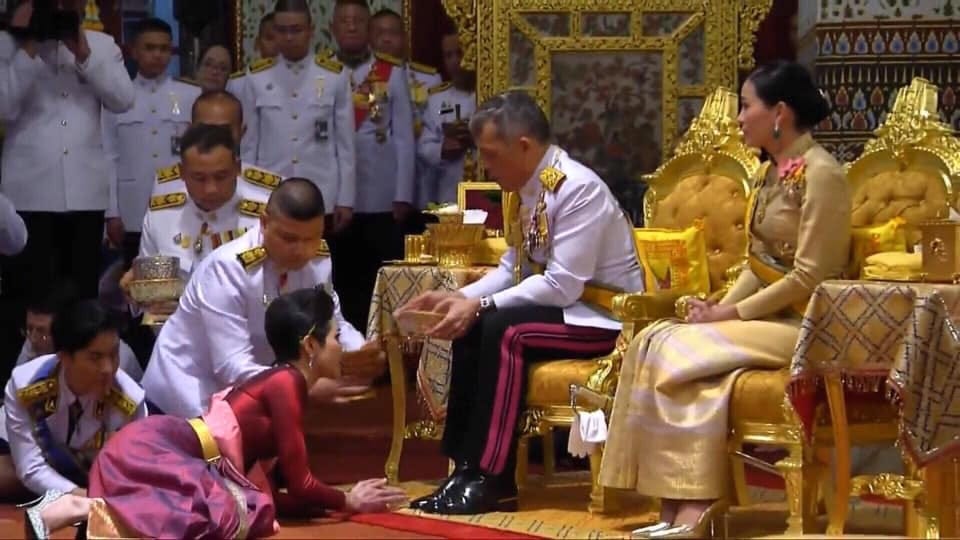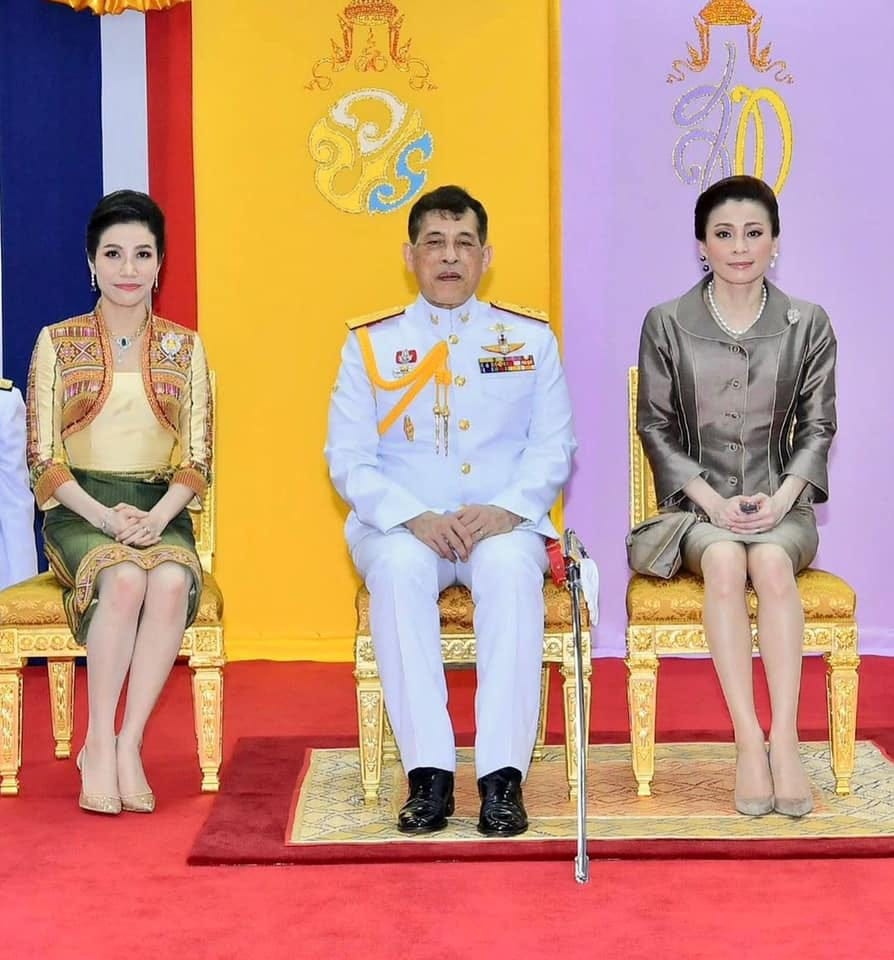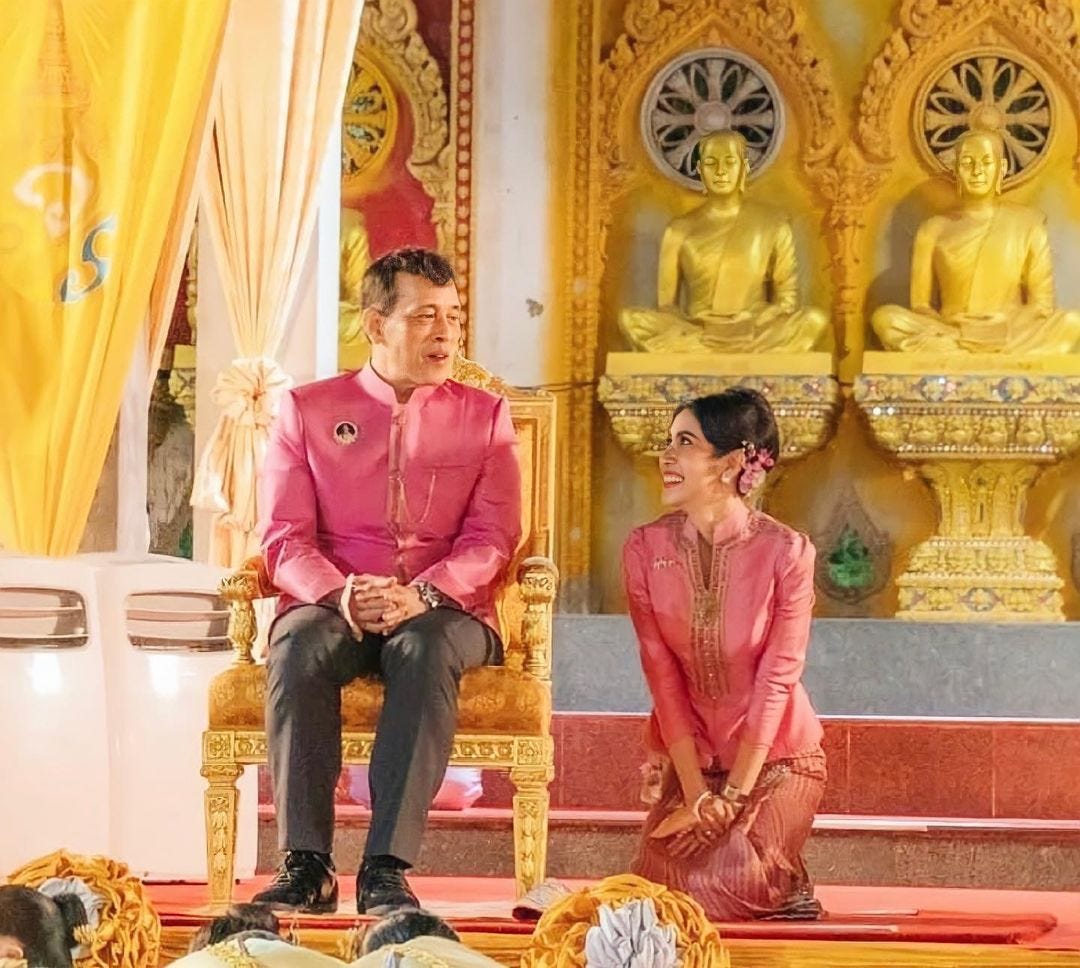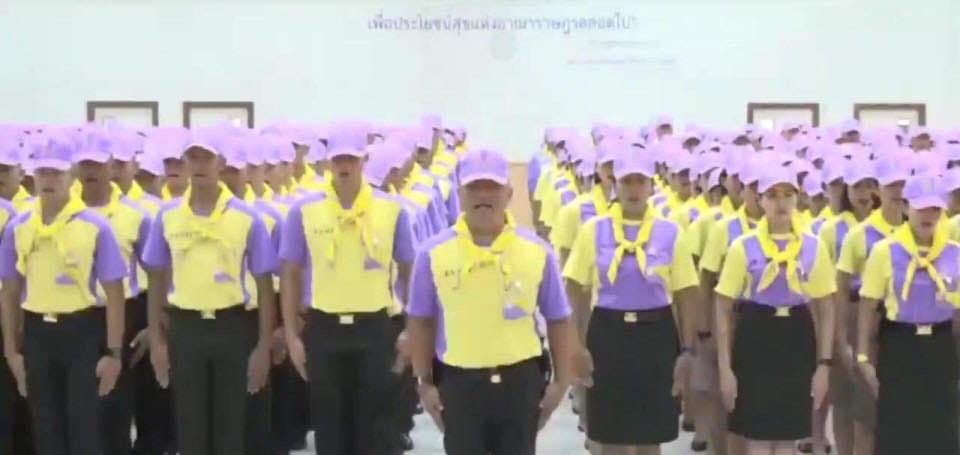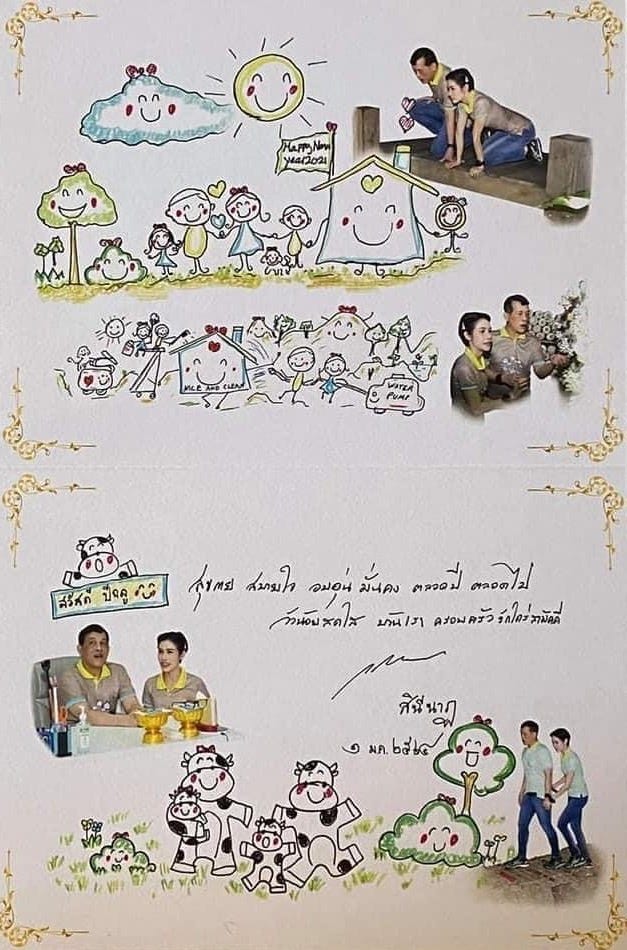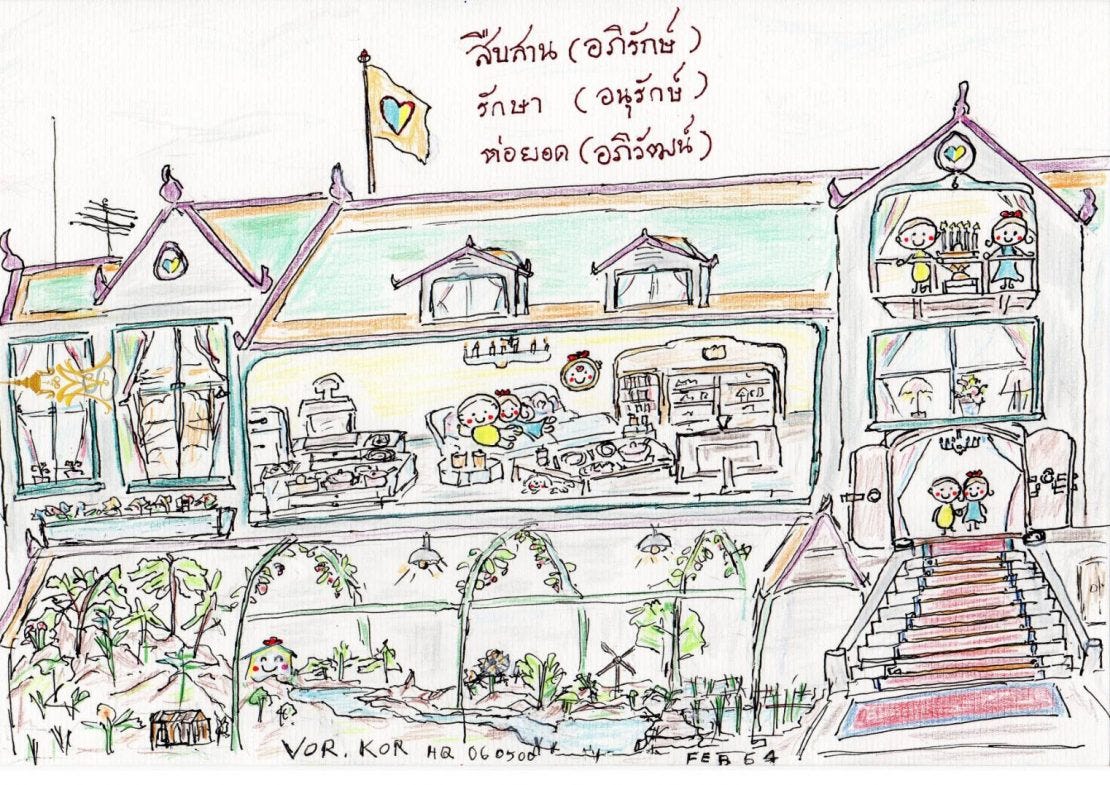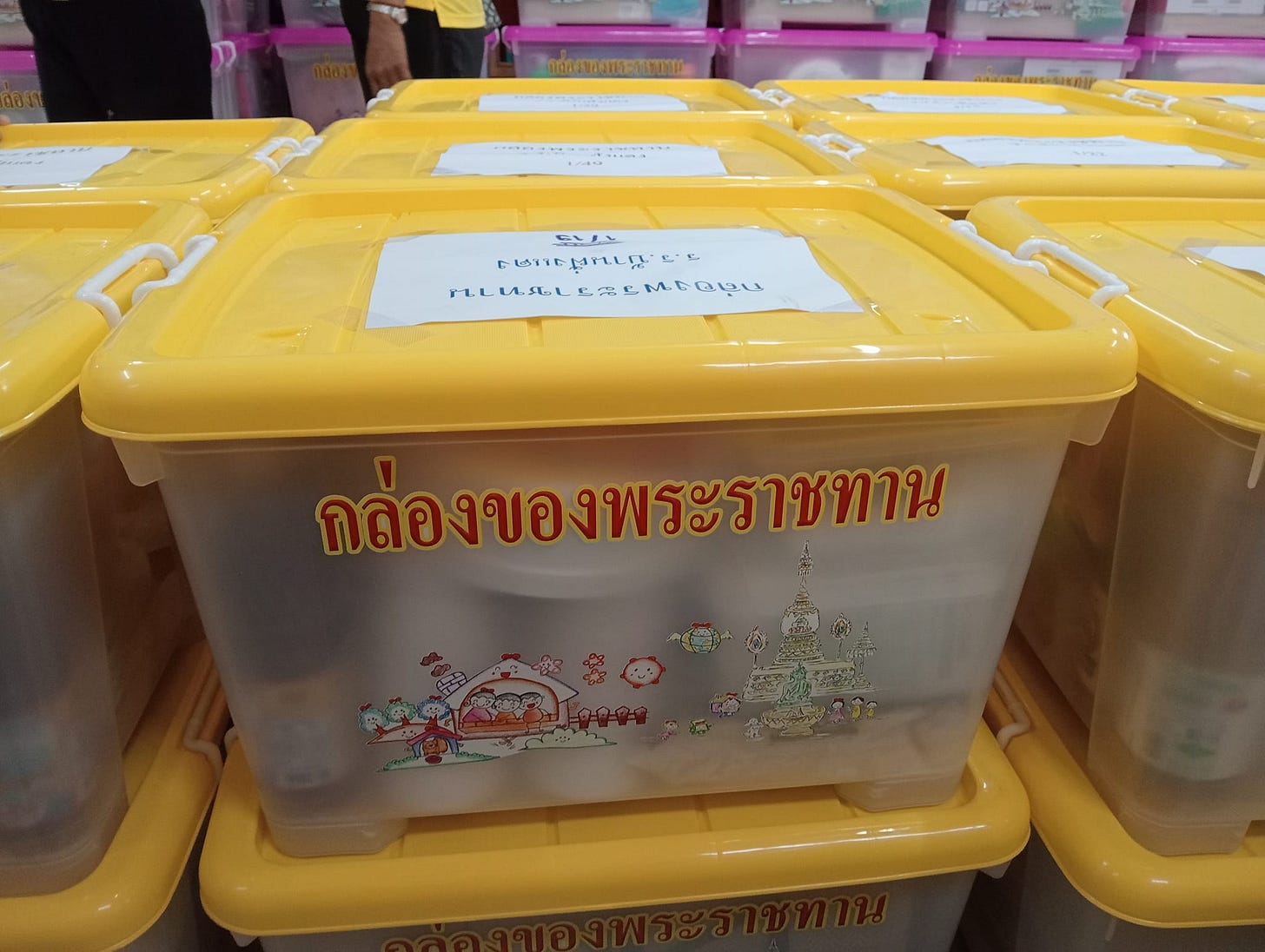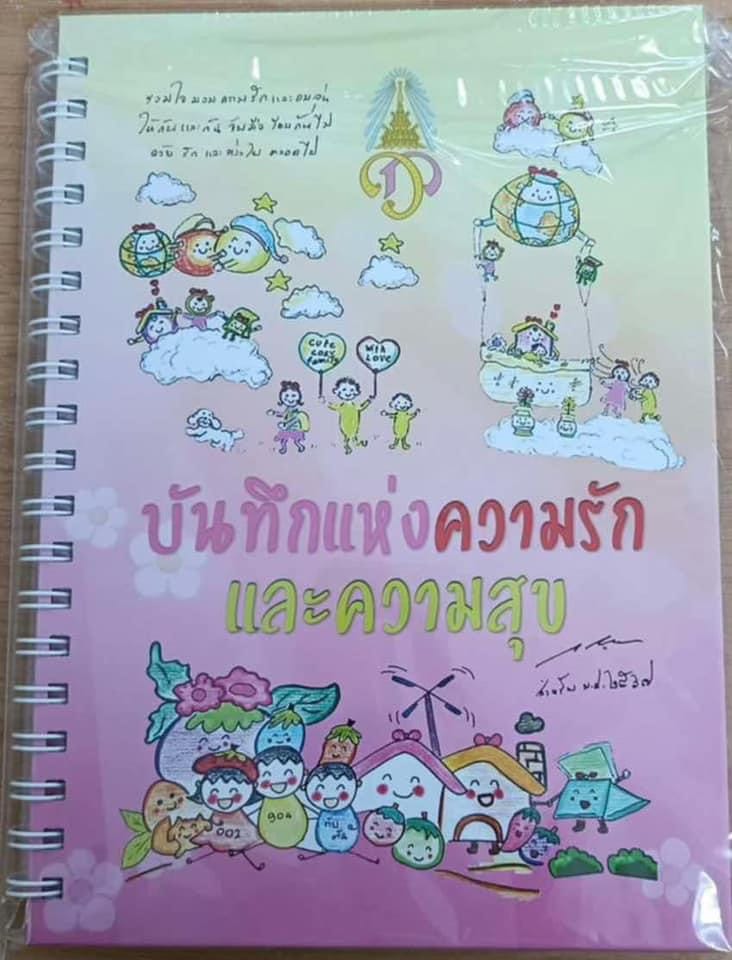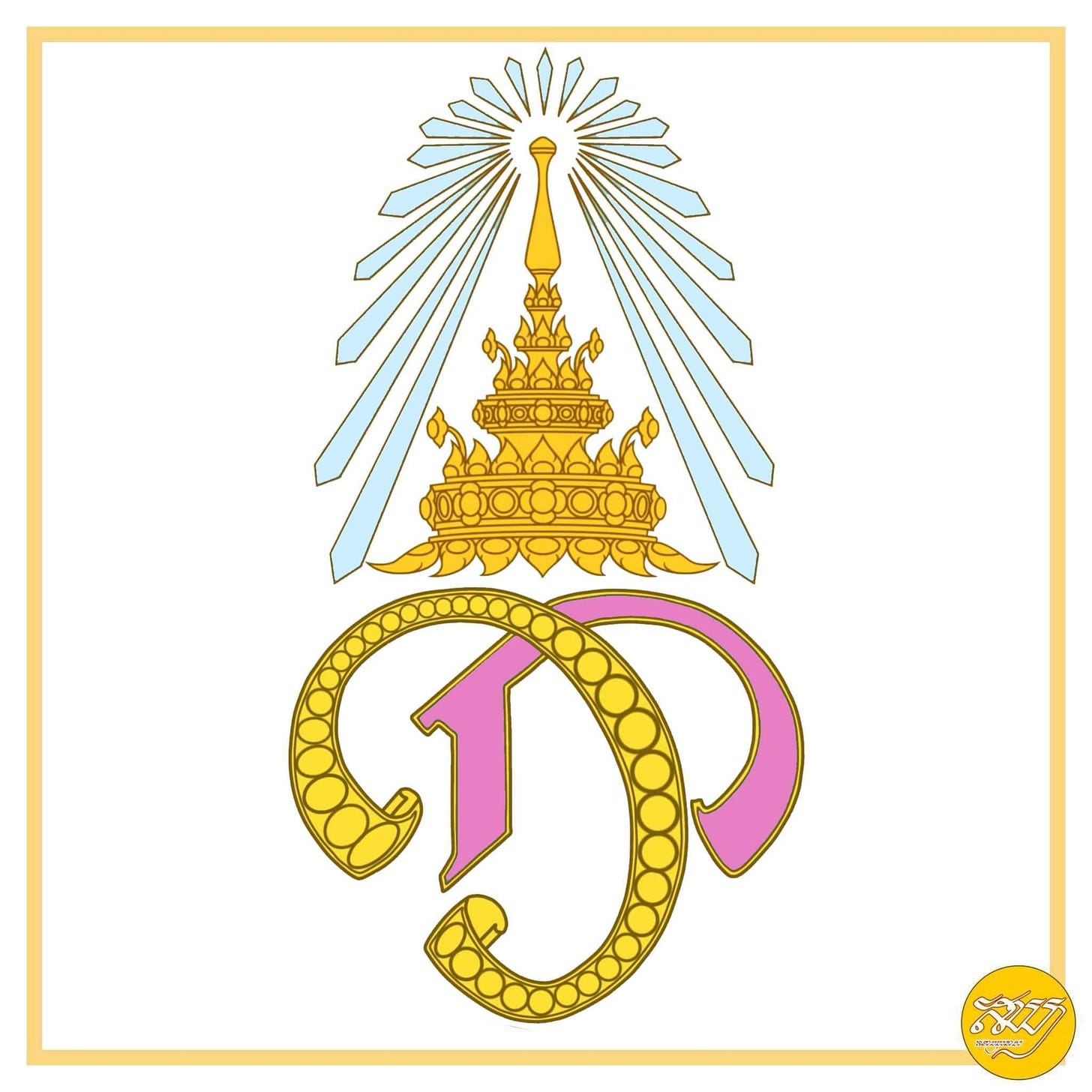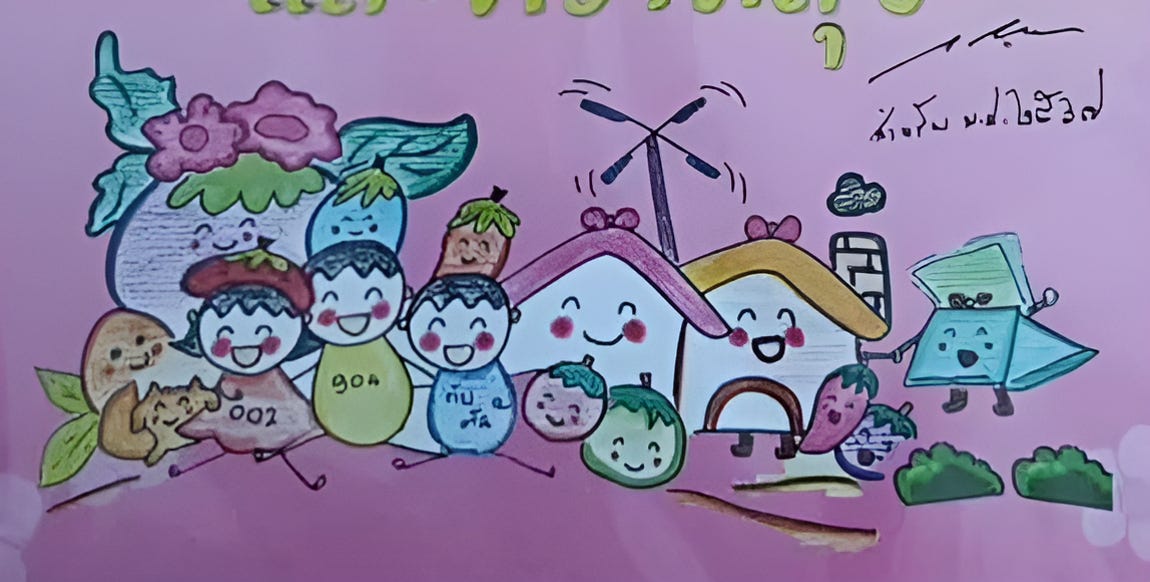Pretty in pink
Thailand's king has fallen head over heels with a new woman. Again.
Secret Siam is fully funded by my readers. Please sign up to receive free updates, and if you would like to receive premium content you can subscribe for $5 a month or $50 a year.
Thank you to all my subscribers for your support. 🙏
Several of the images in this article are taken from the anonymous Facebook page สมเด็จพระจักรพรรดินีศรีศศิเฌอปรางวัชรสุภางควดี which is an excellent source of reliable information on the royals. As always I am also indebted to the insights of Ajarn Somsak Jeamteerasakul.
I. Record of Love and Happiness
Vajiralongkorn Bodindradebayavarangkun is a prolific doodler.
Besides his other favourite pastimes such as cruelty and sadism, cycling, political meddling, collecting planes as garden ornaments, and public semi-nudity, Thailand’s monarch enjoys drawing infantile pictures depicting kitsch sentimental scenes of happy families and social harmony, in which everybody is always smiling — not just humans but clouds, houses, plants, fruit and vegetables, and the sun too.
His New Year card for 2018 is a typical example. On one side, the ghost of the king’s late father Bhumibol, looking dapper in a suit and tie in the afterlife, peers benevolently down from the clouds at Vajiralongkorn and his mother Sirikit. On the other, Vajiralongkorn has shared some of his signature doodles.
Most of Vajiralongkorn’s sketches share similar characteristics. They tend to show an idealised family unit, with a loving father and mother, a son and a daughter, and a pet white toy poodle. In the New Year card above the poodle can be seen three times — to the right of the bicycle in the top image, sheltering under an umbrella in the middle doodle, and beside the snowman in the lowest drawing.
Vajiralongkorn is famously fond of toy poodles. He owns several, although the most famous, his beloved Foo Foo, upon whom he bestowed the rank of Air Chief Marshal, died in 2015 and was cremated after a four-day funeral. You can read more about him and other palace pets in my article “A history of modern Thailand in five royal dogs”.
There are plenty of other clues in Vajiralongkorn’s cartoons that he is depicting an idealised image of himself. It’s odd that he usually only shows two children in the doodles — a son and a daughter — when in fact he has two acknowledged daughters, Bajrakitiyabha and Sirivannavari, as well as his son Dipangkorn, plus four more sons who were banished from Thailand in 1996.
But the poodle is a giveaway, and he also uses colours to signal who his scribbles represent. In Thailand, each day of the week is represented by a different auspicious colour, a remnant of ancient Hindu astrological beliefs that still persist in Thailand today.
Both Vajiralongkorn and his formerly revered father Bhumibol were born on a Monday, so their colour is yellow. This is why the extremist royalist activists who worshipped Bhumibol and spent years trying to sabotage Thaksin Shinawatra and his family wore yellow clothing, and became the so-called Yellow Shirt movement.
The king’s sister Sirindhorn was born on a Saturday so she’s purple. Her royal flag is purple, her supporters wear purple in her presence, and if you ever have dinner or stay the night at the Kempinski Hotel at Siam Paragon in Bangkok you will be struck by the peculiar preponderance of purple. Sirindhorn owns the land and has a large stake in the business.
The father figure in Vajiralongkorn’s crudely drawn cartoons is always yellow. It’s very sad he’s been so emotionally stunted and damaged by being born into the Chakri dynasty that he can only express himself via childish drawings that suggest a yearning for a happy family life he has never had, and never will have. He may be murderous, mad and malevolent, but he’s also a spoiled and needy little boy who never grew up and who craves affection.
His doodles frequently include clues about his life. The colour of the father never changes, but the colour of his female companion sometimes does, reflecting his latest favourite consort.
Vajiralongkorn officially wed his fourth wife, former Thai Airways flight attendant Suthida Tidjai, on May 1, 2019, shortly before his formal coronation. She became queen of Thailand. Her colour is purple, because her birthday, June 3, 1978, was a Saturday.
But by the time of the marriage he was already sick of Suthida, and obsessed with a new favourite — former army nurse Niramon “Koi” Ounprom. The king likes bestowing new names on his concubines, so Koi became Sineenat Wongvajirabhakdi.
wong วงศ์ = family
vajira วชิร = Vajiralongkorn
bhakdi ภักดี = loyal
Niramon was born on January 26, 1985. Although this was a Saturday, Sineenat’s birth was before dawn so under Thailand’s arcane colour conventions, her hue is Friday’s light blue.
Less than three months after marrying Suthida, on his 67th birthday Vajiralongkorn humiliated the queen by making Niramon an official concubine, bestowing the archaic rank of royal noble consort upon her and pouring lustral water from a conch shell onto her head as she prostrated on the floor at his feet in a posture that demonstrated total subservience, at a ceremony right in front of his appalled wife.
It was another step backwards towards the era of absolute monarchy and kingly polygamy.
Sineenat got yet another new surname — Bilaskayani.
bilas พิลาส = beauty
kalyani กัลยาณี = noble
Having a wife and an ambitious official concubine inevitably caused conflict and rivalry, and the princesses Bajrakitiyabha and Sirivannavari became involved in the infighting because they got on well with Suthida and didn’t like Sineenat.
During an extended visit to Bangkok in October 2019, the tensions erupted, and after a huge argument in the palace, Vajiralongkorn stripped Sineenat of all of her royal titles and ordered her to be imprisoned at the Central Women’s Correctional Institution at Lat Yao. The regime, of course, made no attempt to block this blatant extrajudicial punishment. A royal statement accused Sineenat of being “not content with the title bestowed upon her” and “doing everything to rise to the level of the queen”.
Vajiralongkorn’s sudden and savage mood swings are another symptom of his impaired emotional growth. So too is his tendency to become obsessed with a favourite woman — never his wife — and to make childishly ostentatious declarations of devotion. By August 2020 had forgiven Sineenat and flew her on one of his private Boeing 737 planes to reunite with him in Bavaria.
This was the start of a renewed ordeal of constant humiliation for the queen. Sineenat routinely accompanied Vajiralongkorn and Suthida on royal engagements, causing excruciating awkwardness for everybody except the oblivious monarch.
By the end of 2020, Vajiralongkorn had thrown caution to the wind and was openly infatuated with Sineenat. The pair of them increasingly began appearing in public without Suthida, often wearing matching colour coordinated outfits.
The rivalry between Suthida and Sineenat led to multiple changes of uniform for the cult-like Chit Arsa civilian militia that Vajiralongkorn had established, partly modelled on the anti-communist Village Scout movement his parents had fostered in the 1970s.
Sineenat was heavily involved in the conceptualisation and creation of Chit Arsa in 2017, and to acknowledge this the uniform was yellow and blue.
After her fall from grace in 2019, the uniform was hastily changed to yellow and purple, to reflect Suthida’s colour. Then after Sineenat was rehabilitated in 2020, the uniform changed back to the previous colours.
Vajiralongkorn also expressed his devotion to Sineenat via his cartoonish scribbles — like a lovestruck schoolboy (or schoolgirl) signalling their obsession with their latest crush by doodling on the cover of their homework jotter.
His card for New Year 2021 included photographs of himself and Sineenat, and drawings of a loving couple coloured yellow for the male and light blue for the female, with two children and a white poodle, as usual. A flag flying from a smiling anthropomorphised house declared “Happy New Year 2021” and even a hill in the background was smiling.
There was no sign or mention of Suthida anywhere on the card.
Another cartoon released in February 2021 was drawn on Sineenat’s personal notepaper, as can be seen by her insignia on the left of the page — the interlinked letters MVS, for Mahidol, Vajiralongkorn and Sineenat, in yellow and blue. The figures in the cartoons were also colour coded — yellow for Vajiralongkorn and light blue for Sineenat— and so was the flag with a heart insignia flying over the palace.
By early 2021, Sineenat was pressuring Vajiralongkorn to elevate her from her rank as a royal noble consort and make her a queen. It would have been the first time since the reign of King Chulalongkorn, Rama V, that a Thai king had more than one queen.
The besotted monarch was willing to agree, and intended to hold a ceremony on her birthday on January 26 to bestow the title upon her. But the plan was furiously opposed by the king’s daughters Bajrakitiyabha and Sirivannavari, who were aghast that they would have to move down a notch in the royal hierarchy if Sineenat became queen, and would have to show deference to a woman they loathed.
In the end, it never happened, and over the year that followed, Vajiralongkorn seems to have gradually got bored of Sineenat. She was last seen in public at a ceremony for the birthday of the late King Bhumibol on December 5, 2021. After that, she disappeared from view once again. My article “Koi Gone” tells the full story of the rise and fall, and rise again and fall again, of Sineenat.
Queen Suthida appeared to have weathered the storm, and regained the support of Vajiralongkorn.
Until now.
Over the past month, in an unexpected palace initiative, Royal Guard soldiers and Chit Arsa volunteers have been distributing so-called royal gift boxes in various parts of Roi Et province. The boxes are decorated with more of Vajiralongkorn’s doodles. Some have yellow lids, some pink.
Inside each box are various items including a spiral-bound diary, also decorated with the king’s artwork, and entitled “Record of Love and Happiness”.
There are several intriguing aspects to this latest doodle. As usual it is cloyingly cheesy, with a grinning rosy-cheeked family, smiling vegetables and houses and planets and an unidentifiable square blue thing, plus of course a white poodle.
But unusually, at the top it has a version of Vajiralongkorn’s royal crest we have never seen before — the monogram is yellow and pink.
The family depicted at the bottom is also a bit different from past doodles. There’s a father, presumably supposed to be yellow although the printing has rendered him in a hue more like mucus green, marked with the number 904, which denotes Vajiralongkorn. During Bhumibol’s reign, the senior royals were identified by a number in radio communications. Bhumibol was 901 and Vajiralongkorn was 904.
There is a son, shaded blue which is Dipangkorn’s colour, marked with the word “captain”.
And there’s a pink woman with the number 002, never previously seen in his drawings.
Who is she and why does she have a number? To answer that question we have to rewind the story to the Bavarian alps a decade ago.


